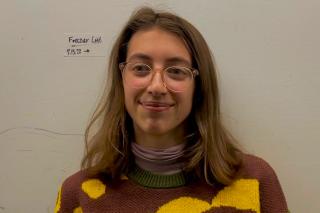In a co-authored article, "Facile Methods for Reusing Laboratory Plastics in Developmental Biology Experiments," published in the journal Differentiation, Maggie Clancy integrates developmental biology and sustainability in impactful ways.
Tell us about your research project that was published in Differentiation.
The project is an attempt to lessen the amount of plastic that is used in research laboratories, specifically in life science and developmental biology laboratories. In my research, I wanted to standardize methods to wash and reuse plasticware that is used in these research settings. I worked with Assistant Professor of Biology John Young and Isabel Wade, a UC Davis student that hails from Boston. Both Dr. Young and Ms. Wade played integral parts in completing the research and I am beyond thankful for their support and hard work. I would also like to give a shout out to the inclusive and supportive environment built in the Young Lab, which enriched my time at Simmons.
First, we identified the problem. Plastic dishes are commonly used in laboratory experiments because they are cheaper than glass dishes and are very sterile. However, this means that the plastic dishes are single-use, creating a waste problem. The goal was to produce a set of cleaning methods and collect data on how efficient they are in hopes that other laboratories will see this research and apply the cleaning methods to their lab procedures to lessen plastic waste.
Understanding this goal, we chose cheap and accessible cleaning products, such as Bleach and 70% Ethanol, to encourage widespread application. Using Xenopus laevis frogs as a model system, we first tested whether the cleaning methods would harm the frogs' development, and secondly, performed standard developmental biology experiments to determine whether the cleaning methods affected experimental integrity. We found that the frogs were able to survive and develop normally in cleaned and reused dishes and the experimental outcomes were not impacted by the cleanings. Ultimately, bacterial contaminants were eliminated and dishes were returned to sterility equal to unused dishes.
We also performed a cost-benefit evaluation. Since we used cheap cleaning products, our methods succeeded in reducing costs otherwise allocated to plasticware. This project brought together developmental biology, economics, and sustainability perspectives.
What do you hope the impact of this research will be?
Even small labs can generate thousands of pounds of plastic waste. By publishing this research, other labs can see that there are effective ways to diminish plastic waste and save money. By providing data and standardizing cleaning methods, it becomes far more likely that other labs will adopt this procedure.
How was your experience participating in the Passionate Leaders Project?
The PLP is a grant, which gave me experience writing a grant proposal and making a budget, which resulted in me receiving funding based on my research needs. I was able to receive money to buy frogs, plastic dishes, and cleaning supplies to conduct our experiments.
Why did you choose Simmons?
My grandmother went to Simmons, so I was aware of its good reputation. I am from the Midwest, and I was really attracted to all of the opportunities for students in the Boston area. I studied science as well as history, which historically have been male-dominated fields, and I received a well-rounded education at Simmons.
What have you been doing since graduation?
I have started a job as a beekeeper with a beekeeping company called Best Bees. Best Bees is a company that provides beekeeping services to clients who decide to house a hive. The beekeepers collect data from the individual hives to evaluate honey bee populations, health, and behavior in the Northeast and work in tangent with a laboratory that samples DNA present in honey to track what plants are being pollinated. From an environmental science perspective, this job allows me to play a role in maintaining and supporting the natural components of an urban ecosystem.
What is most rewarding about your work in environmental science?
Young people now belong to a generation that is confronted with a huge amount of environmental problems that have long been ignored. Because the field of environmental science is so interdisciplinary, you can channel your passions into solutions to environmental issues. What I did at Simmons and what I do now for work is rewarding as it finds direct solutions to environmental problems such as plastic pollution and, now, pollinator health. These seem like separate issues, but the purpose of education, all the random jobs you may work to put yourself through school, and individual life experiences is to combine all of the skills you have learned to serve a purpose beyond yourself.

